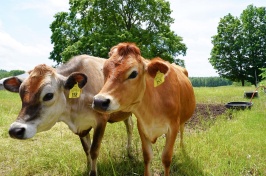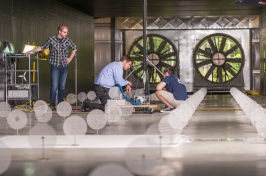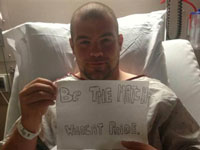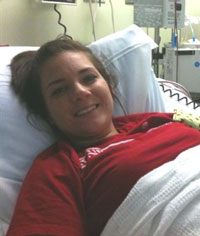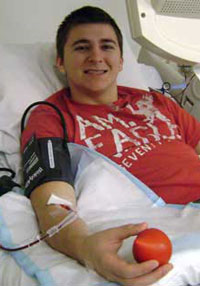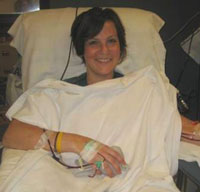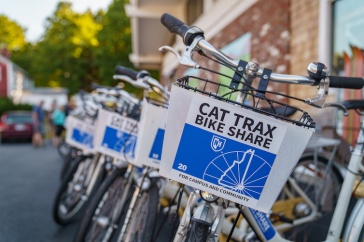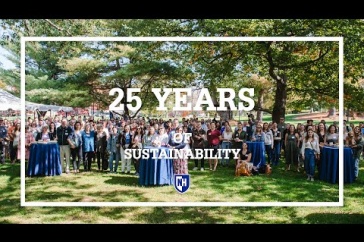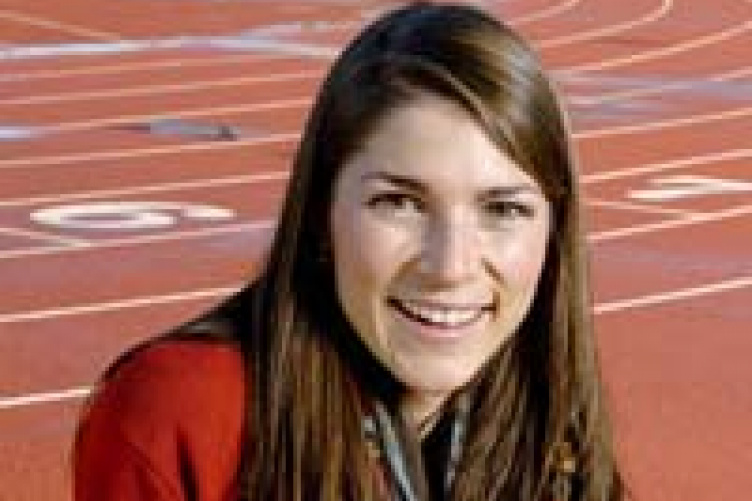
Catie Perrella '11 Photo by Lisa Nugent
The National Marrow Donor Program lists nearly 10 million people on its “Be the Match” registry. One in 20,000 of those will have the right makeup to help a cancer patient who needs a lifesaving bone marrow transplant. And 1 in 540 of those will go on to actually make the donation.
During the last few years, four UNH students and a Residence Hall Director have been that one. Most recently, senior Cameron Lyle made national news for giving up his last season on the UNH men’s track team so he could donate bone marrow to a 28-year-old man suffering from acute lymphoblastic leukemia.
There are two ways to harvest bone marrow. The less common method involves inserting hollow needles into the hip bone. The procedure employed 80 percent of the time collects peripheral blood stem cells (PBSC) using needles inserted into the donor’s arm.
Lyle’s was done through his hips.
|
Cameron Lyle '13 |
“They make between 100-200 punctures into your pelvis. The needles are huge. They took almost two liters of my marrow,” said the shot put and discus thrower who missed his last two meets because of the surgery. “But it was a hundred percent worth it. Knowing that a piece of my body could give a man a second chance at life is an inexplicable feeling that I will never forget.
Sure it was a painful process, but you can't measure something like a few days of pain against another man's life. Would I do it again? Tomorrow.”
And, that’s what they all said.
Take Catie Perrella '11, who also gave up track her senior year after a 2009 cheek swab proved she was a match for someone in need of bone marrow.
“I even actually started crying as I couldn't believe that I had actually been matched and would be given the chance to help someone … no matter the risks it may have imposed on me or the loss of a track season, helping someone was much more important," Perrella said. Her transplant, done through peripheral blood stem cell donation, took place in 2011.
|
Amira Kabbara '11 |
Amira Kabbara '11 was a junior when she registered with UNH’s Giovanni’s Team, a group founded by students to host bone marrow drives on campus. Kabbara went into Dana Farber Cancer Institute for the surgery in December 2010. Her bone marrow went to a 60-year-old man with acute lymphoblastic leukemia whose only chance of survival was the transplant.
“For the payoff it gives, it’s the easiest thing in the world. If the patient needed me to, I could do it again. And I would,” Kabbara said, who also had the procedure done through PBSC despite what she called an irrational fear of needles.
|
Erik Poulin '13 |
Erik Poulin '13 doubled the odds when he matched not one but two cancer patients waiting for a transplant. His procedure was done in 2011 in an effort to save the life of 65-year-old woman with leukemia.
“I’d do it again in a heartbeat. This woman could be someone’s mother. Whether the person is two or 62 — it doesn’t matter if it helps someone,” Poulin said. “If I’m lucky, further down the road I’ll get to know more. I’d love to meet her,” the Hampstead, N.H. native said. “I feel pretty blessed that I had the opportunity to help someone. It’s a great feeling.”
Bone marrow, a spongy tissue found inside certain bones, contains stem cells produced by the body's blood cells. Marrow transplants are used to treat people whose own stem cells have been destroyed by chemotherapy and radiation during cancer treatment. The ideal donor is a blood relative. When that’s not possible, patients look to marrow registries.
|
Lindsay Furlong |
Lindsay Furlong, a residence hall director in Alexander Hall, participated in a bone marrow registry drive while a student at Western New England, six years before her 2011 donation. Her procedure was done at the Rhode Island Blood Center in Providence.
Lyle first registered to be a donor through “Be the Match” launched by the National Marrow Donor Program and brought to UNH in 2008 by head football coach Sean McDonnell who had heard about the registry through another university football coach.
“Be the Match” has student athletes recruiting other students to “get in the game, save a life,” McDonnell said.
“They go into the dorms, into Holloway Commons, trying to get kids to sign up. It takes 15 minutes to get a cheek swab,” McDonnell said. “Everyone on the team participates. It’s amazing; a really great program.”
After Lyle’s transplant at Massachusetts General Hospital, word of his sacrifice — both sacrifices, the donation and having to quit track — got out. He was on all the major morning news shows, and in local and national newspapers. Members of the media contacted him right before the transplant and just days after.
“The media frenzy was nuts,” Lyle says. “But it was obviously worth it if so many people have joined the registry because of my story. I’d tell anyone to get tested. I’d do it all again. I've said it before, it's a no-brainer.”
Learn more about Be the Match.
Originally published by:
UNH Today
-
Written By:
Staff writer | Communications and Public Affairs






























